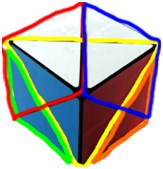
Dino cube flip edge piece free#
But if you ever have a question about anything, feel free to leave a comment on one of my videos! I try my best to reply to questions. This gives a combined upper bound of 62 6 1212 2 arrangements. This leaves us with 6 vertex pieces with 2 orientations, 12 edge pieces, and two sets of 12 centre pieces. Furthermore, the centres split in two sets that don't intermingle. I highly encourage checking it out.Īlthough I highly recommend it, you don't have to subscribe to my YouTube channel. This shows that the vertex pieces have only two orientations, and the edges only one. No cuber has ever told me they regret going, and most people (including myself) regret not going early enough. You might be thinking, "competitions!?" Competitions are actually just events where cubers can meet up and hang out (and do some official solves). You can use their website to check world records, and look for competitions near you. The World Cube Association (WCA) handles cubing events and official records. The second puzzle pictured above is the Rainbow Cube. The side of the cube with the edge piece that needs to be rotated is going to be your Front (F).

Use the following algorithm to place the edge pieces and to complete the second layer. Press the play button to see the animations. This is the fastest way to flip an edge: F takes the edge to the equator, U moves the empty spot in place, R moves the edge up in the top again, now well-oriented, U restores the position. Versions with 6 colours (pictured above) were also made, as well as with only 4 or 2 colours. Down (clockwise 90 degrees) Right (clockwise 90 degrees) 3. The most complicated case is when three edges are done and the last one is oriented wrong. It is called a dino cube because it originally had pictures of dinosaurs on the sides. There is an active community of cubers with hundreds of thousands of people who just enjoy speedsolving and/or solving a variety of puzzles! You can find us on Reddit, Facebook, the SpeedSolving Forums, and other decentralized places like YouTube and Instagram. There are twelve moving pieces, one on each edge of the cube. Check out my sub-11 second average using a total of 16 algorithms, which is part of what you learn with beginner CFOP. Cubing is much more interesting because that is NOT the case, and there's much more to learn besides algorithms. CFOP does have many algorithms to memorize, but don't be pressured into thinking that learning more algorithms is what makes you faster in the end. My advice is that you should not rush to learn new things until you're well practiced with what you know, otherwise it can feel overwhelming.
Dino cube flip edge piece how to#
But if you want to get even faster, you should learn How to do Finger Tricks and learn the CFOP Method, which is most of the fastest cubers use. Some people stop there, which is totally fine. Congrats on solving the Rubik's Cube! With practice, you should be able to do this in a few minutes, or even under 1 minute if you practice a lot.


 0 kommentar(er)
0 kommentar(er)
